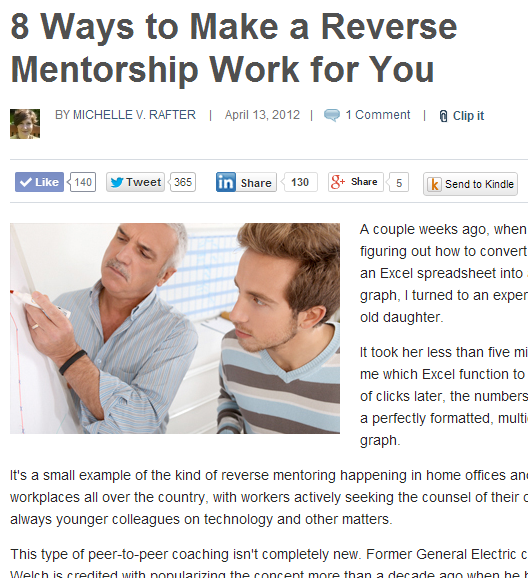If you use images to illustrate your blog posts, you know how hard it can be to find stock photos that have any relation to real life. Lean In, the women’s empowerment organization started by Facebook COO Sheryl Sandberg, is doing something about it, announcing this week it has co-created with Getty Images a library of 2,5000 stock images of women of all ages at work and at home.
Finding stock photos that are representative of women and men of various ages, races, abilities, careers and life situations isn’t just a problem for bloggers. The quality of stock images running with stories I’ve done for major national news outlets is appalling. Here are a few examples from stories I’ve done:






Notice common themes in these pictures? Here, let me help:
- A majority of the people are white, young, and wrinkle or blemish free.
- The offices the photos depict are sterile, stark and 99% of the time filled with sun-lit windows or gleaming white walls – just like where you work, right?
- They’re trite, using stacks of coins to illustrate a story about money, and airplanes for a piece about business travel.
- They’re sterotypical – the equivalent of the power mom holding a baby and a briefcase that the Lean In-Getty Images collaboration is meant to correct.
- Whether showing offices or households, they’re devoid of clutter or any of the other stuff you’d find in either one of those environments.
Editors Aren’t Entirely to Blame for Bad Stock Photos
I don’t put all the blame for the prevalence of bad stock images on editors, and I’m not just saying that because I work as one. Editor are busy, they might not have a photo staff, or a budget to buy anything beyond the cheapest stock photos. In other words, they’re doing the best with what they’ve got to work with – and it isn’t much. I know. At some point in the past few years, I’ve been that editor. The guy in the picture above gazing out the airport window, I picked that. Ditto the stack of gold coins.
Why We Need a New Kind of Stock Photo Library
The pickings are especially slim if you write about subjects such as business and technology, like I do. Technology changes so fast, a stock photo of a laptop or smartphone that looks modern today will be woefully outdated a year from now. The same goes for office trends: while the vast majority of Americans work for small businesses, the vast majority of stock images of workplaces make it look like we all work in high-rise office towers.
If you’ve collaborated with me on editorial projects I’ve managed over the past four years, you’ve heard me complain about the lack of good stock photos, and that goes for some of the finest, most expensive stock libraries, including Getty.
That’s why I was excited when I learned Lean In and Getty are collaborating on the Lean In Collection. The library includes stock photos of people of all races, some with silver hair, others with tatoos, women serving in the military, girls in their school uniforms, runners, doctors, hikers, bikers, swimmers, bakers, office workers, moms, and kids.
Skimming through the colleciton, I still see too many pretty people posed smiling into space — hello, editors looking to use these to illustrate news stories, how-to pieces, evergreen features don’t want picture of people looking at the camera. And way too many photos of office spaces have a stage, air-brushed quality. But I guess they have to start somewhere.
Lean In, Getty and WNYC are inviting people to submit their own photos to be part of the collection by taking a picture and posting it on Twitter or Instagram with the hashtag #NotYourStockWoman.
The partners’ invitation to crowdsource photos has met with mixed reaction. Some Twitter users are using the #NotYourStockWoman hashtag to express their displeasure with requests to give away their photos for free to an agency that charges for its content:
Unpaid/underpaid work is a HUGE problem for working women. Pay female photographers instead of collecting FREE stock pics #NotYourStockWoman
— Bina (@binaemanvel) February 12, 2014
Others aren’t happy with the fact that people of color are being asked to help promote a project they see as a “white corporate movement”:
#NotYourStockWoman because my body and my mind will not be commodified to help you diversify a white corporate movement.
— Suey Park (@suey_park) February 12, 2014
Alternatives to Stock Photos
Whether or not you agree with its intention, the Lean In collection isn’t for everyone — especially if you’re a blogger on a budget. If you’re looking for images for blog posts, there are other options. That’s what I started doing in the past two years to come up with images for this blog. I still use photos that I find on Flickr. but I also use:
- My own photography – Your phone goes everywhere with you anyway, be on the lookout for photo opportunities that you could use for blog posts
- Wikimedia – For historical, archival and vintage photos.
- Word clouds – or other forms of text art or text illustrations, like this one
- Hand-out photos – of authors, book jackets, etc., with permission
- Company logos – usually available on a company’s media or press kit page
A word of warning: even if you’re hard up for material to illustrate a post, you can’t grab any old thing that comes up in a Google image search. You may end up using copyrighted material, which could get you in serious legal trouble.
To see what could happen, read this post: Lesson learned: Bloggers, pay attention when selecting images and make sure you have permission to use them.
More on Illustrating Blog Posts
See what else I’ve written on finding photos for blog posts:
Great post, Michelle! I like the examples. The most embarrassing stock image situation I’ve ever had was when I wrote what I thought was an empathetic, non-degrading/stereotypical feature article about book clubs that cater to people without stable housing. They chose a photo of very clean-cut, Brooks Brothers-wearing (racially diverse, in their defense) co-eds sitting in a circle discussing books. It seemed horribly incongruous with the content of the article but one of my sources pointed out that an image of a sad-looking, stereotypically unkempt homeless person would have been worse. I probably would have chosen something more generic like a stack of books.
Susan, I feel your pain. My most embarrassing stock image story has to be the time I wrote a post for a well-known online news site about how teenagers were using Snapchat and Instagram more than Faceboook. I led with an anecdote about my niece, who was 14 and in eighth grade at the time. The lead was positioned directly across from a story’s hero image (main photo), which was of a heavyset guy who looked like he was in college or older — nothing wrong with the picture per se, but with an anecdotal lead, it just looked weird.
Michelle